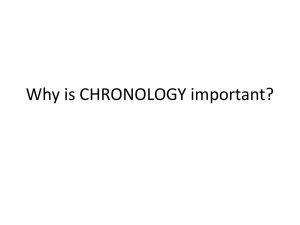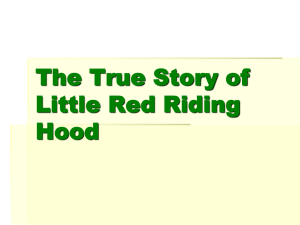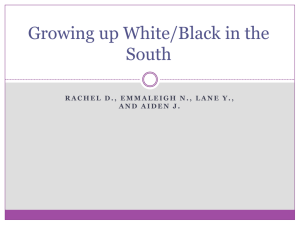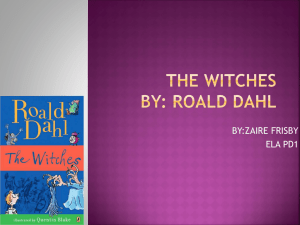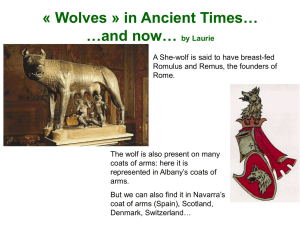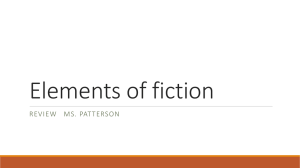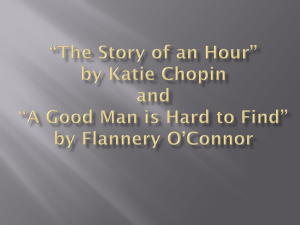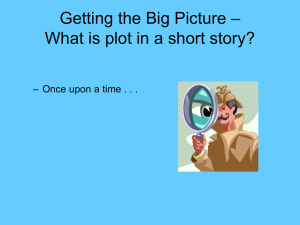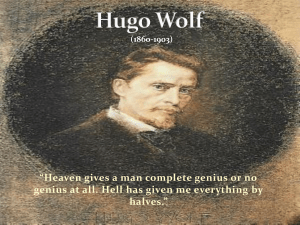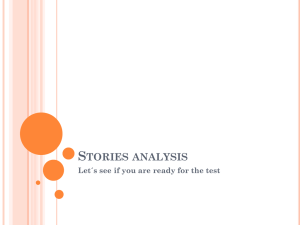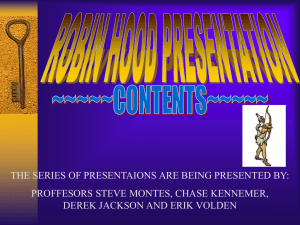The Short Story:
advertisement
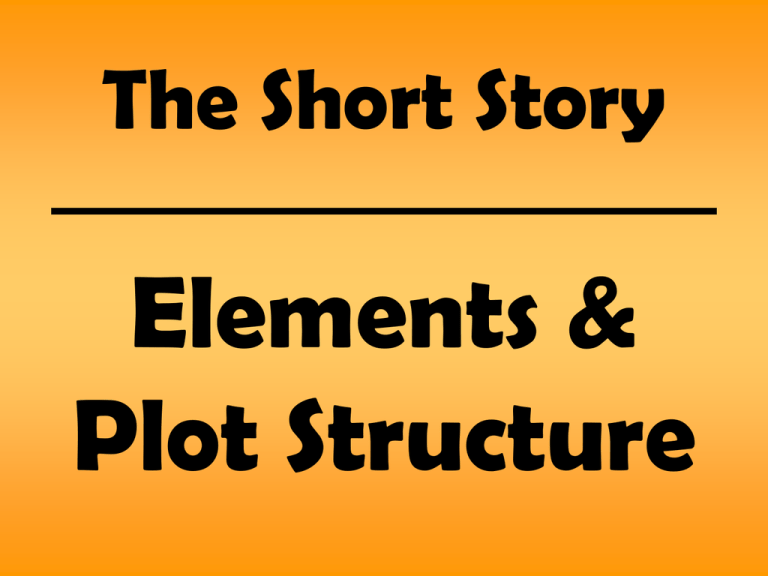
The Short Story Elements & Plot Structure The Short Story Definition • A short story is a form of short fictional narrative prose, tending to be more concise than longer works of fiction. The term most often refers to a work of fiction no longer than 20,000 words and no shorter than 1,000. •Short stories tend to be less complex than novels, focusing on only one incident, with a single plot, a single setting, a limited number of characters, and covering a short period of time. •Short stories have their origins in narrative storytelling and prose anecdote, a swiftly-sketched situation that comes rapidly to its point. •Of course, as with any art form, the exact characteristics of a short story will vary by author. The Short Story Origins Short stories date back to the story-telling traditions which produced such notable tales as Homer's Iliad and Odyssey. Short sections of these tales focused on individual narratives that could be told at one sitting. The overall arch of the story would only emerge through the telling of multiple sections of the tale. Fables, which tend to be folk tales with an explicitly expressed moral, were said by the Greek historian Herodotus to have been invented by a Greek slave named Aesop in the 6th century BCE (although other times and nationalities are also given for Aesop). These ancient fables are known today as Aesop's Fables. The other ancient form of short story, anecdotes, were popular during the years of the Roman Empire. Anecdotes functioned as a sort of parable, a brief realistic narration that embodies a point. Many of the surviving Roman anecdotes were later collected in the Gesta Romanorum in the 13th or 14th century. Anecdotes remained popular in Europe well into the 18th century, when the fictional anecdotal letters of Sir Roger de Coverley were published. The Short Story Origins In Europe, the oral story-telling tradition began to develop into written stories in the early 14th century, most notably with Geoffrey Chaucer's Canterbury Tales and Giovanni Boccaccio's Decameron. Both of these books are composed of individual short stories (which range from farce or humorous anecdotes to well-crafted literary fictions) set within a larger narrative story (a frame story), although the frame tale device was not adopted by all writers. At the end of the 16th century, some of the most popular short stories in Europe were the darkly tragic "novella" of Matteo Bandello (especially in their French translation). During the Renaissance, the term novella was used when referring to short stories. The mid 17th century in France saw the development of a refined short novel, the "nouvelle", by such authors as Madame de Lafayette. In the 1690s, traditional fairy tales began to be published (one of the most famous collections was by Charles Perrault). The appearance of Antoine Galland's first modern translation of the Thousand and One Nights (or Arabian Nights from 1704; another translation appeared in 1710–12) would have an enormous influence on the 18th century European short stories of Voltaire, Diderot and others. Elements Model Obviously, subject matter for short stories over the years has varied wildly, ranging from the mundane to the fantastic. Today, we will look at a familiar story, “Little Red Riding Hood,” to analyze it for elements of the short story. Elements Setting Setting is the time and place of a story’s action, and includes ideas, customs, values, and beliefs. “Little Red Riding Hood” takes place in the woods a long time ago. Elements Characters Characters are the actors in a story’s plot. They can be people, animals, ghosts, mythological creatures, or anything else within the author’s imagination. The PROTAGONIST is the main character. The ANTAGONIST is in conflict with the main character. Not all stories have protagonists. The characters in the story are Little Red Riding Hood, the Big Bad Wolf, the Grandmother, and the woodsman. Little Red Riding Hood is the protagonist. The Big Bad Wolf is the antagonist. Elements Point of View Point of view refers to the relationship of the NARRATOR, or storyteller, of the story. In FIRST-PERSON point of view, the narrator is a character, and is referred to using personal pronouns, including, “I.” In THIRD-PERSON point of view, the narrator reveals thoughts of only one character, referring to that character using pronouns like, “he” or “she.” In THIRD-PERSON OMNISCIENT point of view, the narrator knows everything about the story’s events and reveals the thoughts of all the story’s characters. “Little Red Riding Hood” is traditionally told from the THIRDPERSON OMNISCIENT point of view: the narrator explains what Little Red Riding Hood is doing as well as what is happening to her and her grandmother. Elements Theme Theme is the central idea or message of a story, often a perception about life or human nature. STATED themes are directly presented in a story. IMPLIED themes must be inferred by considering all the elements of a story and asking what message about life is conveyed. The theme of “Little Red Riding Hood” is IMPLIED. While the narrator does not directly state a message, the reader can infer it: be suspicious of things and people that do not appear the way they should. Elements Plot Plot is the sequence of events in a story. Each event causes or leads to the next. Plot is often created through CONFLICT, a struggle between opposing forces. An EXTERNAL conflict is one between a character and an outside force, such as another character, nature, society, fate, etc. An INTERNAL conflict takes place within the mind of a character who is torn between opposing feelings or different courses of action. In “Little Red Riding Hood,” the conflict is EXTERNAL—Little Red Riding Hood versus The Big Bad Wolf. Short Story Triangle Most plots develop in five stages, and can be expressed in the form of a triangle. The chart, first developed in 1863 by Gustav Freytag and consequently also known as “Freytag’s Triangle,” is a diagram of plot structure which shows complication and emotional tension rising like one side of a pyramid toward its apex, which represents the climax of action. Once the climax is over, the descending side of the pyramid depicts the decrease in tension and complication as the work reaches its conclusion and denouement. Freytag designed the chart for discussing tragedy, but it can be applied to many kinds of fiction. Short Story Triangle Most plots develop in five stages: 1. EXPOSITION introduces the story’s characters, setting, and conflict. Exposition Short Story Triangle Most plots develop in five stages: 2. RISING ACTION occurs as complications, twists, or intensifications of the conflict occur Exposition Rising Action Short Story Triangle Climax Most plots develop in five stages: 3. CLIMAX is the emotional high point of the story. Exposition Rising Action Short Story Triangle Climax Most plots develop in five stages: Falling Action 4. FALLING ACTION is the logical result of the climax. Exposition Rising Action Short Story Triangle Climax Most plots develop in five stages: Falling Action 5. RESOLUTION presents the final outcome of the story. Exposition Rising Action Resolution Short Story Triangle Climax Model: “Little Red Riding Hood” Falling Action Little Red Riding Hood has prepared a basket of goodies for her grandmother. She begins walking through dangerous woods to deliver the basket. Exposition Rising Action Resolution Short Story Triangle Climax Model: “Little Red Riding Hood” Little Red Riding Hood has prepared a basket of goodies for her grandmother. She begins walking through dangerous woods to deliver the basket. Exposition Falling Action The Big Bad Wolf spots Little Red walking in the woods and asks her where she’s going with the basket of treats. Rising Action Resolution Short Story Triangle Climax Model: “Little Red Riding Hood” Little Red Riding Hood has prepared a basket of goodies for her grandmother. She begins walking through dangerous woods to deliver the basket. Exposition Falling Action The Big Bad Wolf spots Little Red walking in the woods and asks her where she’s going with the basket of treats. The Wolf runs to the grandmother’s house , eats her, puts on her bonnet, glasses, and night gown, and climbs into her bed. Rising Action Resolution Short Story Triangle Model: “Little Red Riding Hood” Little Red Riding Hood has prepared a basket of goodies for her grandmother. She begins walking through dangerous woods to deliver the basket. Exposition The Big Bad Wolf spots Little Red walking in the woods and asks her where she’s going with the basket of treats. Climax Little Red arrives at her grandmother’s house and sits on a stool at the disguised wolf’s bedside. Falling Action The Wolf runs to the grandmother’s house , eats her, puts on her bonnet, glasses, and night gown, and climbs into her bed. Rising Action Resolution Short Story Triangle Model: “Little Red Riding Hood” Little Red Riding Hood has prepared a basket of goodies for her grandmother. She begins walking through dangerous woods to deliver the basket. Exposition The Big Bad Wolf spots Little Red walking in the woods and asks her where she’s going with the basket of treats. Climax Little Red arrives at her grandmother’s house and sits on a stool at the disguised wolf’s bedside. The Wolf runs to the grandmother’s house , eats her, puts on her bonnet, glasses, and night gown, and climbs into her bed. Falling Action Little Red questions all the things that appear different about her “grandmother.” Rising Action Resolution Short Story Triangle Model: “Little Red Riding Hood” Little Red Riding Hood has prepared a basket of goodies for her grandmother. She begins walking through dangerous woods to deliver the basket. Exposition The Big Bad Wolf spots Little Red walking in the woods and asks her where she’s going with the basket of treats. Climax Little Red arrives at her grandmother’s house and sits on a stool at the disguised wolf’s bedside. The Wolf runs to the grandmother’s house , eats her, puts on her bonnet, glasses, and night gown, and climbs into her bed. Little Red comments on the Wolf’s nose, eyes, ears, and teeth, and he responds by eating her in one gulp. Falling Action Little Red questions all the things that appear different about her “grandmother.” Rising Action Resolution Short Story Triangle Model: “Little Red Riding Hood” Little Red Riding Hood has prepared a basket of goodies for her grandmother. She begins walking through dangerous woods to deliver the basket. Exposition The Big Bad Wolf spots Little Red walking in the woods and asks her where she’s going with the basket of treats. Climax Little Red arrives at her grandmother’s house and sits on a stool at the disguised wolf’s bedside. The Wolf runs to the grandmother’s house , eats her, puts on her bonnet, glasses, and night gown, and climbs into her bed. Little Red comments on the Wolf’s nose, eyes, ears, and teeth, and he responds by eating her in one gulp. Falling Action Little Red questions all the things that appear different about her “grandmother.” Rising Action The Woodsman arrives on the scene to discover the wolf dressed as the grandmother, and quickly surmises what has transpired in the woman’s cottage. Resolution Short Story Triangle Model: “Little Red Riding Hood” Little Red Riding Hood has prepared a basket of goodies for her grandmother. She begins walking through dangerous woods to deliver the basket. Exposition The Big Bad Wolf spots Little Red walking in the woods and asks her where she’s going with the basket of treats. Climax Little Red arrives at her grandmother’s house and sits on a stool at the disguised wolf’s bedside. The Wolf runs to the grandmother’s house , eats her, puts on her bonnet, glasses, and night gown, and climbs into her bed. Little Red comments on the Wolf’s nose, eyes, ears, and teeth, and he responds by eating her in one gulp. Falling Action Little Red questions all the things that appear different about her “grandmother.” Rising Action The Woodsman arrives on the scene to discover the wolf dressed as the grandmother, and quickly surmises what has transpired in the woman’s cottage. The Woodsman kills the wolf and out step the Grandmother and Little Red, happy and safe. Resolution Active Reading Strategies The Short Story PREDICT Make educated guesses about what will happen next by combining clues in the story with what you already know. Predicting helps you anticipate events and stay alert to the less obvious parts of a story. Say to yourself… • I think the title might mean… • I think this character is going to… • Now I think he or she will… • My first prediction doesn’t match what I read. Now I think… Active Reading Strategies The Short Story CONNECT Draw parallels between people, places, and events in the story and the people, places, and events in your life. Ask yourself… • How would the main character act in my situation? • How would I act in the main character’s situation? • When have I felt the same way as the character? • What parts of my life does this remind me of? • What other stories does this remind me of? Active Reading Strategies The Short Story QUESTION Ask yourself questions to help you clarify the story as you go along. Ask yourself… • Do I understand what I’ve read so far? • Why did the character say that? • What’s going on here? • What does this mean? Active Reading Strategies The Short Story VISUALIZE In your mind, form pictures of what is happening in the story. Pay attention to the details the writer gives you, and make them a part of your reading experience. Ask yourself… • How does this scene, character, or object look? • Who is in this scene? • Where are the characters in relation to one another and to their surroundings? Active Reading Strategies The Short Story EVALUATE Form opinions and make judgments about the story while you are reading—not just after you have finished. Ask yourself… • Does this turn of events make sense? • Is this character believable? • What is particularly effective about this writer’s style? • Do I agree with this idea? Active Reading Strategies The Short Story REVIEW Pause every page or two to think about your reading. Summarize events in the story or rephrase difficult language to help you understand and remember what you’ve read. Say to yourself… • So far, … • In other words… Active Reading Strategies The Short Story RESPOND Respond while you are reading. React to different parts of the story. Say to yourself… • I like this character because… • I’d like to ask the writer why… • I wish I could visit this place because…
